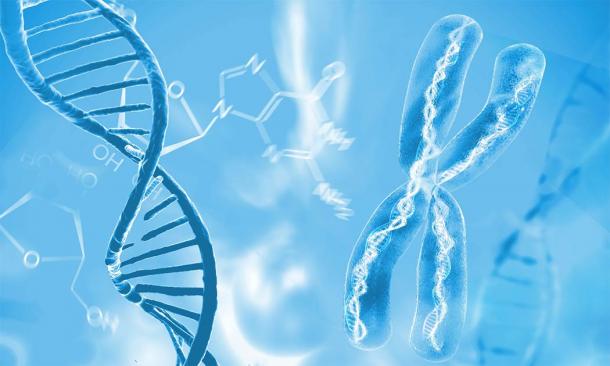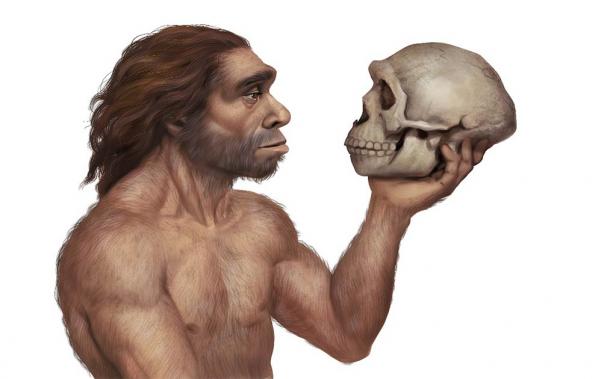Early human interbreeding with our “cousins” the Denisovans and Neanderthals is an established fact but newly sequenced Neanderthal Y-chromosomes tell scientists that modern humans are the product of a complex history of interspecies sex. Neanderthals had lived in Eurasia for more than 300,000 years, when our modern human ancestors left Africa in the most recent wave some 60,000–70,000 years ago. When the two groups met in Eurasia around 45,000-years-ago they mated and a whole new kind of human was formed. Recent research confirms early human interbreeding but also provides evidence that makes our earliest encounters with both Neanderthals and Denisovans a much more complicated relationship.
According to the 2010 publication of the Neanderthal draft genome sequence, a comparison of the Neanderthal draft genome with modern human sequences revealed that about “2 percent of the DNA in the genomes of modern-day people with Eurasian ancestry, is Neanderthal in origin,” most notably expressed in the skin, hair and diseases of modern people. While it is known that Neanderthals left their genetic mark in the DNA of modern humans, less was known about the reverse flow of Homo sapiens’ DNA into Neanderthals when the two species met in Eurasia around 45,000 years ago.
However, a new study on early human interbreeding has shown that those Neanderthals already had Homo sapiens’ genes on board from “much earlier encounters,” and the new research also suggests the Homo sapiens’ Y-chromosome had “completely replaced the original Neanderthal Y chromosome sometime between 370,000 and 100,000 years ago.”

DNA double helix molecules and chromosomes: the forensic evidence that proves early human interbreeding and when. (Giovanni Cancemi / Adobe Stock )
A Re-examination Of Early Human Interbreeding Based On Genes
The X and Y chromosomes are the two sex chromosomes in mammals, including humans, and they determine the biological sex of an individual. Females inherit an X chromosome from the father for a XX genotype, while males inherit a Y chromosome from the father for a XY genotype. Only mothers can pass on the X chromosome.
The new paper by evolutionary geneticists Martin Petr and Janet Kelso, from the Max Planck Institute for Evolutionary Anthropology , presents details of their team’s new method of sequencing Y-chromosome DNA, in their quest to understand early human interbreeding. The study results were based on Y-chromosome DNA sequencing of “two Denisovans and three Neanderthals samples gathered from sites in France, Russia and Spain dating between 38,000 to 53,000 years ago.” The results confirm early human interbreeding with these two species of hominins. But the results of the study also indicate that these prehistoric sexual encounters resulted in “a really complicated population history spanning thousands of years and several continents.”
Modern Human DNA Entered The Neanderthal Population Slowly
Archaeologists and anthropologists have discovered several bones, which when gene sequenced, prove that a Neanderthal and a Denisovan had mated. Previous studies of non-sex chromosomes have established that Neanderthals and Denisovans share a branch of the human family tree, which split off sometime between 700,000 and 550,000 years ago.
However, according to this new paper “the Y-chromosomes tell a different story, suggesting our most recent common ancestor lived around 370,000 years ago.” This means that a long time after the three different groups had split up and evolved into different populations, they met up again and mated again. The paper says that “over time, our version of the Y-chromosome genome ended up replacing the Neanderthal version.” Therefore, early human interbreeding first occurred a long time ago, and then, after a very long break, it happened again.
In case you didn’t know already, an “ allele” is one of two or more versions of a known gene mutation identified at the same location on a chromosome. Previous gene studies have mostly all indicated that modern human “alleles” probably entered the Neanderthal gene pool slowly. How slowly? At a speed, determined by Petr, Kelso, and their colleagues, to be “roughly single-digit percentage of the population,” which according to the scientists isn’t enough to become fixed.

A Neanderthal man holding a Neanderthal’s skull perhaps wondering how much of his DNA was from modern humans and Denisovans. Today, we are wondering the same thing! (Roni / Adobe Stock )
Unfortunately, Most Ancient Hominin Bones Are Female
This very slow rate of change in the Neanderthal DNA makeup suggested to the researchers that Homo sapiens’ Y-chromosome alleles may have offered some kind “of fitness advantage,” when compared with the Neanderthal versions.
To prove or disprove this theory, a computer simulation was created in which a Y-chromosome allele from Homo sapiens was passed on to one percent of the Neanderthal population. Even at one percent, the model showed that the chances of replacing the older Neanderthal version over a 50,000-year period only “shot up to about 25 percent, suggesting that whatever selective edge Homo sapiens alleles offered, it may have been tiny, but that’s enough to stick around.”
The exact nature of this genetic “selective advantage,” which was written into Homo sapiens ‘ Y-chromosome DNA, is yet unknown because of a distinct lack of Denisovans and Neanderthal genome samples. As fate would have it, the archaeological record is heavily populated by female Neanderthals and female Denisovans but almost void of male remains, and it’s the men that pass on the Y chromosomes. Hopefully, over time, more male Neanderthals and male Denisovans will be found and more gene sequencing can be carried out to solve the selective advantage puzzle. But it is very interesting to know that we modern humans carry a complex DNA mixture that could only come from early human interbreeding with other hominins over a very long period of time.
Top image: Early human interbreeding is well known but a recent research study has shown that modern humans both received and gave DNA to Neanderthals, proving that these hominin cousins met more than once in the long arc of prehistoric time. Source: AlienCat / Adobe Stock
By Ashley Cowie
Related posts:
Views: 0
 RSS Feed
RSS Feed
















 September 26th, 2020
September 26th, 2020  Awake Goy
Awake Goy  Posted in
Posted in  Tags:
Tags: 
















